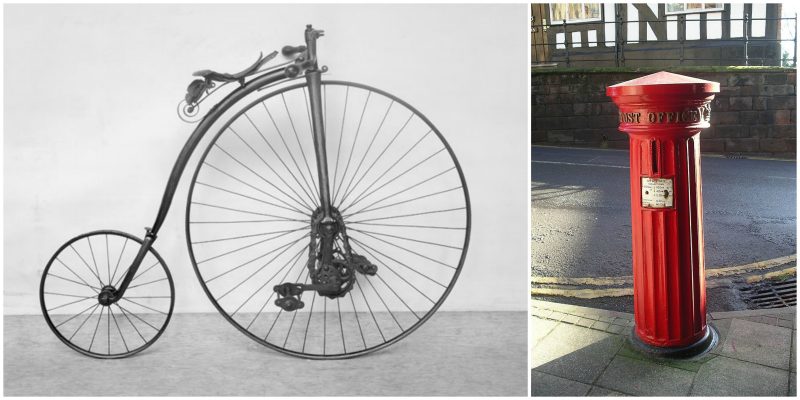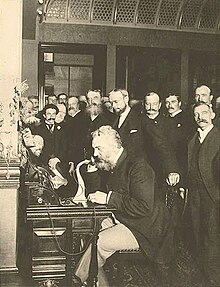Historians have characterized the mid-Victorian era, (1850–1870) as Britain’s ‘Golden Years.’There was prosperity, as the national income per person grew by as much as half. Much of the prosperity was due to the increasing industrialization, especially in textiles and machinery, as well as to the worldwide network of trade and engineering that produced profits for British merchants, often a result of exports from across the globe.
The Victorian period was also very important in terms of innovation, many thing that we used today were invented in this era.
1.Postage Stamp known as “Penny Black”
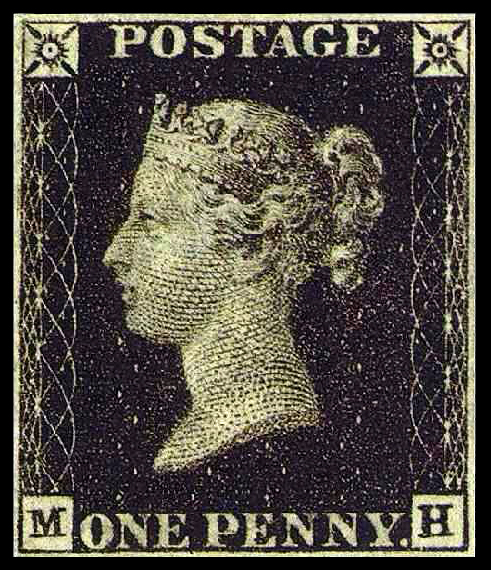
Although a number of people laid claim to the concept of the postage stamp, it is well documented that stamps were first introduced in the United Kingdom of Great Britain and Ireland on 1 May 1840 as a part of postal reforms promoted by Sir Rowland Hill. With its introduction, the postage fee was paid by the sender and not the recipient, though it was still possible to send mail without prepaying. From when the first postage stamps were used, postmarks were applied to prevent the stamps being used again.
The first stamp, the “Penny black”, became available for purchase 1 May 1840, to be valid as of 6 May 1840. Two days later, 8 May 1840, the Two pence blue was introduced. The Penny black was sufficient for a letter less than half an ounce to be sent anywhere within the UK. Both stamps included an engraving of the young Queen Victoria, without perforations, as the first stamps were separated from their sheets by cutting them with scissors. The first stamps did not need to show the issuing country, so no country name was included on them. The UK remains the only country to omit its name on postage stamps, using the reigning monarch’s head for national identification. Following the introduction of the postage stamp in the UK, prepaid postage considerably increased the number of letters mailed. Before 1839, the number of letters sent in the UK was typically 76 million. By 1850 this increased five-fold to 350 million, continuing to grow rapidly until the end of the 20th century when newer methods of indicating the payment of postage reduced the use of stamps.
2.Christmas Card
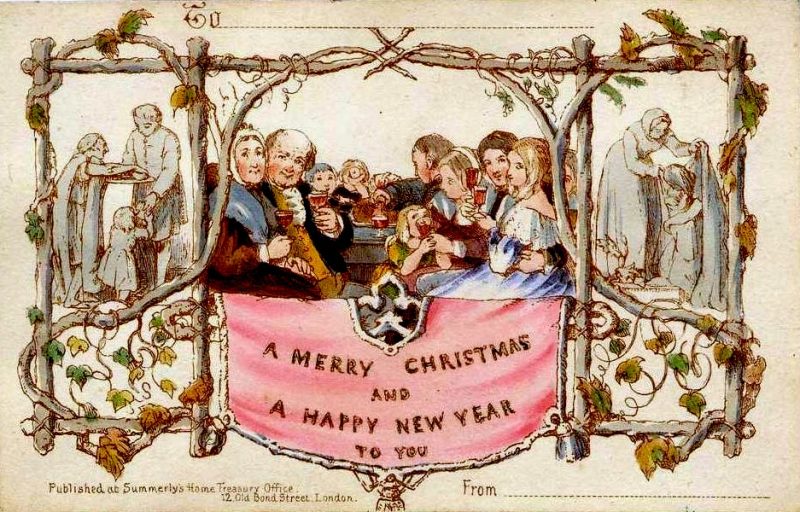
The first Christmas cards were commissioned by Sir Henry Cole and illustrated by John Callcott Horsley in London on 1 May 1843. The central picture showed three generations of a family raising a toast to the card’s recipient: on either side were scenes of charity, with food and clothing being given to the poor. Allegedly the image of the family drinking wine together proved controversial, but the idea was shrewd: Cole had helped introduce the Penny Post three years earlier. Two batches totaling 2,050 cards were printed and sold that year for a shilling each.
Early English cards rarely showed winter or religious themes, instead favoring flowers, fairies and other fanciful designs that reminded the recipient of the approach of spring. Humorous and sentimental images of children and animals were popular, as were increasingly elaborate shapes, decorations and materials. At Christmas 1873, the lithograph firm Prang and Mayer began creating greeting cards for the popular market in England. The firm began selling the Christmas card in America in 1874, thus becoming the first printer to offer cards in America. Its owner, Louis Prang, is sometimes called the “father of the American Christmas card.” By the 1880s, Prang was producing over five million cards a year by using the chromolithography process of printmaking.However, the popularity of his cards led to cheap imitations that eventually drove him from the market. The advent of the postcard spelled the end for elaborate Victorian-style cards, but by the 1920s, cards with envelopes had returned. The extensive Laura Seddon Greeting Card Collection from the Manchester Metropolitan University gathers 32,000 Victorian and Edwardian greeting cards, printed by the major publishers of the day,including Britain’s first commercially produced Christmas card.
3.Rubber Tire

The first patent for what appears to be a standard pneumatic tire appeared in 1847 lodged by the Scots inventor Robert William Thomson. However, this never went into production. The first practical pneumatic tire was made in 1888 for his son Johnnie’s tricycle, in May Street, Belfast by Scots-born John Boyd Dunlop, proprietor of one of Ireland’s most prosperous veterinary practices. It was an effort to prevent the headaches his 10-year-old son was given him, by jarring himself, while riding on rough pavements. His doctor, John, later Sir John Fagan, had prescribed cycling as an exercise for the boy and, a regular visitor, Fagan participated in the development of the first pneumatic schemes. In Dunlop’s tire patent specification dated 31 October 1888 his interest is only in its use in cycles and light vehicles. In September 1890 he was made aware of an earlier development, but the company kept the information to itself.
In 1892 Dunlop’s patent was declared invalid because of a prior patent by forgotten fellow Scot Robert William Thomson of London (patents London 1845, France 1846, USA 1847), although Dunlop is credited with “realizing rubber could withstand the wear and tear of being a tire while retaining its resilience”.
4.Concrete
Joseph Monier, a French gardener and known to be one of the principal inventors of reinforced concrete, was granted a patent for reinforced flowerpots by means of mixing a wire mesh to a mortar shell. In 1877, Monier was granted another patent for a more advanced technique of reinforcing concrete columns and girders with iron rods placed in a grid pattern. Though Monier undoubtedly knew reinforcing concrete would improve its inner cohesion, it is less known if he even knew how much reinforcing actually improved concrete’s tensile strength.
Before 1877 the use of concrete construction, though dating back to the Roman Empire and reintroduced in the mid to late 1800s, was not yet a proven scientific technology. American New Yorker Thaddeus Hyatt published a report titled An Account of Some Experiments with Portland-Cement-Concrete Combined with Iron as a Building Material, with Reference to Economy of Metal in Construction and for Security against Fire in the Making of Roofs, Floors, and Walking Surfaces where he stated his experiments on the behavior of reinforced concrete.
His work played a major role in the evolution of concrete construction, so that it became a proven and reliable method. Without Hyatt’s work and more dangerous trial and error methods contributed greatly to the advancement in this building technology.
5.Post Box

In the British Isles, the first red pillar post boxes were erected in Jersey in 1852.Roadside wall boxes first appeared in 1857 as a cheaper alternative to pillar boxes, especially in rural districts. In 1853 the first pillar box in the United Kingdom was installed at Botchergate, Carlisle. In 1856, Richard Redgrave of the Department of Science and Art designed an ornate pillar box for use in London and other large cities. In 1859 the design was improved, and this became the first National Standard pillar box. Green was adopted as the standard colour for the early Victorian post boxes. Between 1866 and 1879 the hexagonal Penfold post box became the standard design for pillar boxes and it was during this period that red was first adopted as the standard colour. The first boxes to be painted red were in London in July 1874, although it would be nearly 10 years before all the boxes had been repainted. In 2012 to celebrate Olympic gold medals for Team GB, selected boxes are painted gold. One was vandalised briefly with graffiti, before being re-painted.
6.Typewriter
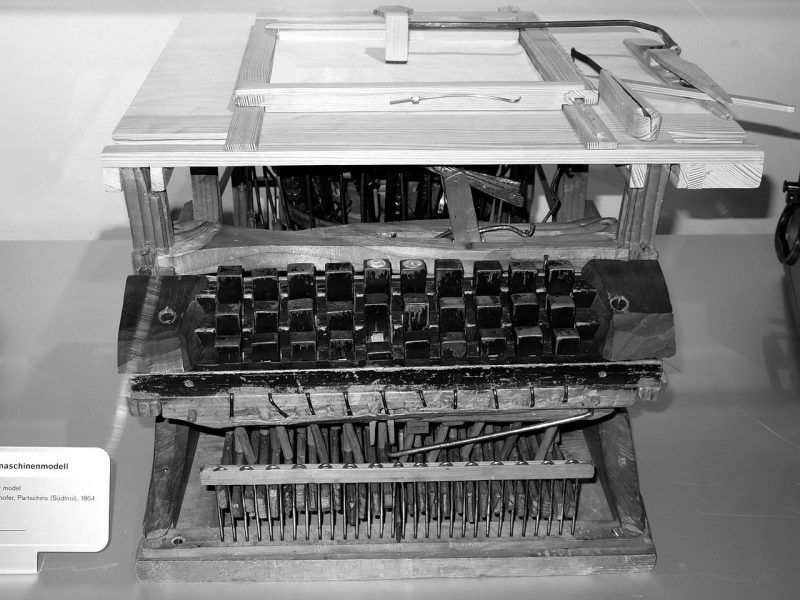
In 1865, Rev. Rasmus Malling-Hansen of Denmark invented the Hansen Writing Ball, which went into commercial production in 1870 and was the first commercially sold typewriter. It was a success in Europe and was reported as being used in offices in London as late as 1909.Malling-Hansen used a solenoid escapement to return the carriage on some of his models which makes him a candidate for the title of inventor of the first “electric” typewriter. According to the book Hvem er skrivekuglens opfinder? (English: Who is the inventor of the Writing Ball?), written by Malling-Hansen’s daughter, Johanne Agerskov, in 1865, Malling-Hansen made a porcelain model of the keyboard of his writing ball and experimented with different placements of the letters to achieve the fastest writing speed. Malling-Hansen placed the letters on short pistons, that went directly through the ball and down to the paper. This, together with the placement of the letters so that the fastest writing fingers struck the most frequently used letters, made the Hansen Writing Ball the first typewriter to produce text substantially faster than a person could write by hand. The Hansen Writing Ball was produced with only upper case characters.
Malling-Hansen developed his typewriter further through the 1870s and 1880s and made many improvements, but the writing head remained the same. On the first model of the writing ball from 1870, the paper was attached to a cylinder inside a wooden box. In 1874, the cylinder was replaced by a carriage, moving beneath the writing head.
6.Telephone
Before the development of the electric telephone, the term “telephone” was applied to other inventions, and not all early researchers of the electrical device called it “telephone”. A communication device for sailing vessels The Telephonewas the invention of a captain John Taylor in 1844. This instrument used four air horns to communicate with vessels in foggy weather.Later, c. 1860, Johann Philipp Reis used the term in reference to his Reis telephone, his device appears to be the first such device based on the conversion of sound into electrical impulses, the term telephone was adopted into the vocabulary of many languages. It is derived from the Greek: τῆλε, tēle, “far” and φωνή, phōnē, “voice”, together meaning “distant voice”.
Credit for the invention of the electric telephone is frequently disputed. As with other influential inventions such as radio, television, the light bulb, and the computer, several inventors pioneered experimental work on voice transmission over a wire and improved on each other’s ideas. New controversies over the issue still arise from time to time. Charles Bourseul, Antonio Meucci, Johann Philipp Reis, Alexander Graham Bell, and Elisha Gray, amongst others, have all been credited with the invention of the telephone.In 1876, Scottish emigrant Alexander Graham Bell was the first to be granted a United States patent for a device that produced clearly intelligible replication of the human voice. This instrument was further developed by many others. The telephone was the first device in history, that enabled people to talk directly with each other across large distances. Telephones rapidly became indispensable to businesses, government, and households, and are today some of the most widely used small appliances.
7. Penny-farthing bycyle
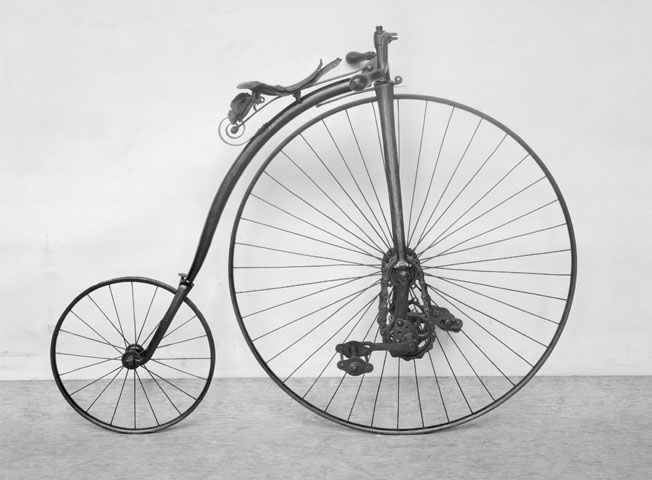
Eugène Meyer of Paris, France is now regarded as the father of the high bicycle by the International Cycling History Conference in place of James Starley. Meyer patented a wire-spoke tension wheelwith individually adjustable spokes in 1869.They were called “spider” wheels in Britain when introduced there.Meyer produced a classic high bicycle design during the 1880s.
James Starley in Coventry added the tangent spokes and the mounting step to his famous bicycle named “Ariel”. He is regarded as the father of the British cycling industry. Ball bearings, solid rubber tires and hollow-section steel frames became standard, reducing weight and making the ride much smoother.
